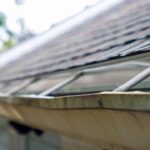Rain gutters and downspouts do more than finish your home’s exterior—they protect it from water damage. In many areas, rainfall can harm your home’s foundation, landscaping, and basement if not managed well. Gutters channel rainwater away from the structure, preventing soil erosion, flooding, and ugly water stains. Without them, rain can pool near the foundation, leading to expensive repairs.
While many homeowners choose professional installation, doing it yourself can be cost-effective and satisfying. Whether you’re fixing an existing system or installing new gutters, tools and materials are easy to find at home improvement stores. From vinyl and aluminum sections to stylish brackets and DIY gutter guards, there are many options to customize your rainwater management system.
In this guide, we’ll show you how to install reproduction half-round gutters. This attractive and functional option mimics the classic look of historic homes. This style suits older architecture and pairs well with corrugated downspouts and decorative cast-aluminum brackets for a timeless finish. Get ready to boost both the performance and curb appeal of your home.
Overview on Rain Gutters
Rain gutters are vital for a home’s drainage system. They collect rainwater from the roof and direct it away from the foundation. Without proper gutters, rain can cause serious damage. This includes eroding soil, harming landscaping, staining siding, and even flooding basements or crawlspaces.
Gutters come in different shapes, materials, and styles, like K-style and half-round. They are usually made from aluminum, vinyl, galvanized steel, or copper. Each material has its own traits in durability, looks, and price. Downspouts connect to the gutters and carry water down to the ground. They guide water away from the home using splash blocks or underground drainage.
Regular maintenance is essential for gutters to work well. Leaves, twigs, and debris can block them and cause overflow. This can lead to water damage. Many homeowners add gutter guards to cut down on cleaning needs.
Whether you install them yourself or hire a pro, gutters are a wise investment. They protect your home’s structure and look while helping maintain property value.
What Happens If You Don’t Have Gutters?
Not having gutters on your home may seem harmless, but over time, it can lead to serious and expensive damage. Gutters play a crucial role in directing rainwater away from your house. Without them, uncontrolled runoff from the roof can cause the following problems:
1. Foundation Damage
Water falling directly near the base of your home can pool around the foundation. Over time, this weakens the foundation, causes cracks, and may even lead to basement leaks or structural instability.
2. Soil Erosion
The constant flow of rainwater can erode the soil around your house, washing away landscaping and creating uneven ground. This can affect the stability of walkways, driveways, and patios.
3. Basement Flooding
When water isn’t properly channeled away, it often finds its way into basements or crawlspaces, leading to moisture buildup, mold growth, and water damage.
4. Siding and Exterior Damage
Without gutters, rainwater can splash back onto the siding, causing stains, rot, and paint damage. Over time, this reduces curb appeal and increases maintenance costs.
5. Roof Damage
Improper drainage can also cause water to back up onto the roof, leading to shingle damage, leaks, and even wood rot in the roof deck.
How to Install Gutters in 10 Steps
1. Measure Your Roofline
Use a measuring tape to determine how much guttering you’ll need. Measure the length of each roof edge where gutters will be installed.
2. Choose Your Gutter Type and Materials
Select the gutter style (K-style or half-round) and material (aluminum, vinyl, steel, etc.) based on your home’s design and climate needs.
3. Mark the Slope
Mark a slight slope (about 1/4 inch per 10 feet) toward the downspout location to ensure proper water flow.
4. Install Gutter Hangers or Brackets
Attach gutter hangers along the fascia board, following your slope line. Spacing should be every 2–3 feet.
5. Cut the Gutters to Length
Use a hacksaw or tin snips to cut gutter sections to fit your measured lengths.
6. Attach End Caps and Outlets
Seal the ends of each gutter section with end caps. Cut holes and install outlets for downspouts at marked locations.
7. Mount the Gutters
Snap or screw the gutter sections into the hangers securely, ensuring they follow the slope.
8. Seal the Joints
Use gutter sealant to waterproof the seams and joints between sections.
9. Install Downspouts
Attach downspouts to the outlets and secure them to the wall using brackets. Extend the bottom to divert water away from the foundation.
10. Test for Leaks
Run water through the system with a hose to check for leaks or blockages. Make adjustments as needed.
Read More: How To Fix Sagging Gutters Without Replacing Them
If Adding a Rain Barrel…
A rain barrel is a smart, eco-friendly addition to your gutter system. It collects rainwater from your roof through the downspouts. You can store this water and reuse it for tasks like watering plants, washing cars, or cleaning outdoor spaces.
Here are a few things to keep in mind if you’re planning to install a rain barrel:
1. Choose the Right Location Place the rain barrel under a downspout close to your garden or area where you’ll use the water. Make sure the ground is level and stable to support the weight of a full barrel.
2. Modify the Downspout Cut the downspout so it ends just above the barrel’s intake opening, or install a downspout diverter kit that channels water directly into the barrel while allowing overflow to continue through the downspout.
3. Use a Screen Filter Install a screen or mesh filter at the top of the barrel to keep out leaves, debris, and mosquitoes.
4. Provide an Overflow Outlet Ensure your rain barrel has an overflow valve or outlet to direct excess water away from your home’s foundation during heavy rainfall.
5. Use a Hose or Spigot Most barrels come with a spigot at the bottom so you can easily attach a hose or fill watering cans.



